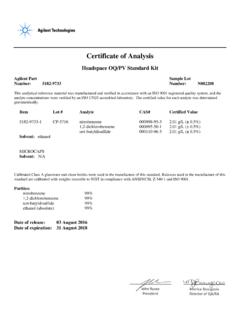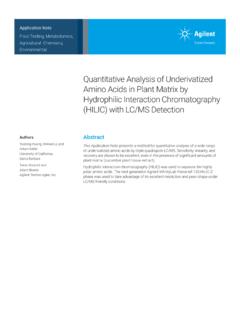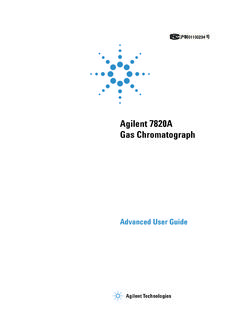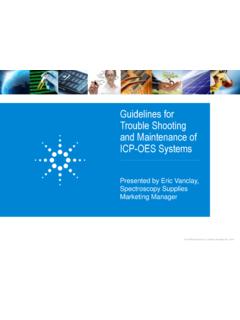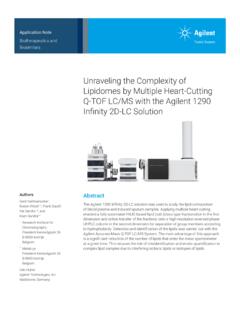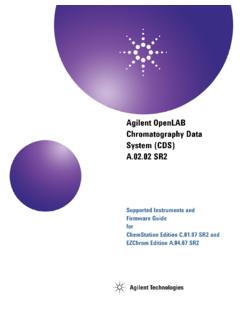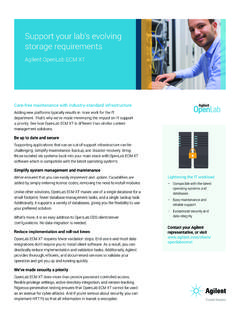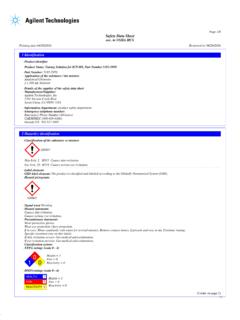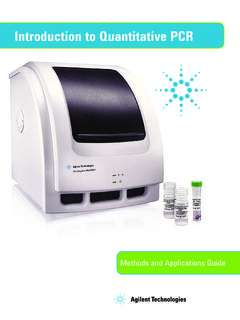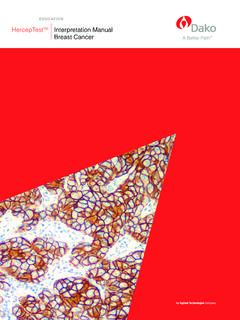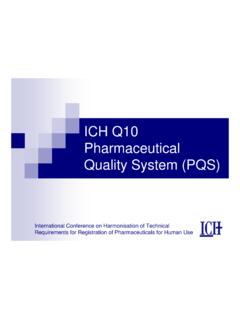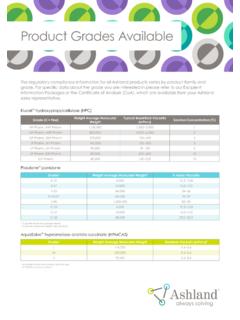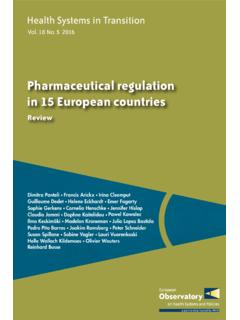Transcription of Pharmaceutical Analysis Using UV-Vis: Compliance with USP …
1 Application Note IntroductionUV-Vis spectroscopy is a widely used analytical technique in quality assurance/quality control (QA/QC) and Pharmaceutical research. It is critical that any laboratory in such environments set up appropriate controls for laboratory access and ensure that Good Manufacturing Practice (GMP) documentation, including system suitability tests (SSTs) and standard operating procedures (SOPs) are available and followed. The United States pharmacopeia (USP) and the European pharmacopeia (Ph. Eur.)
2 Guidelines describe how to verify that the analytical performance of UV-Vis spectrophotometers is suitable for the intended operational range of the Analysis . Pharmaceutical Analysis Using UV-Vis: Compliance with USP Chapter <857>, and European Pharmacopoeia (Ph. Eur. Chapter ) Meeting the requirements of the global pharmacopeias with the Agilent Cary 3500 UV-Vis2 Within Cary UV Workstation software for the Cary 3500, a range of system verification tests are available and automated. These tests align with the pharmacopeia requirements, while also allowing the flexibility to cover a limited custom test list.
3 USP general chapter <857> and Ph. Eur. chapter guide instrument operational Table 1, continued. United State Pharmacopeia (USP) system verification tests recommended for the Cary 3500 UV-Vis Category USP Test Description and LimitsControl of PhotometricLinearity MethodAt least three different absorbance levels appropriate to and spanning the required operational range are of Photometric Linearity Recommended Reference MaterialSuitable certified reference material Potassium Dichromate (K2Cr2O7) solutionsUV 200 400 nm, all concentrations must meet accuracy of absorbance acceptance Light MethodProcedure A: Produce the differential spectrum resulting from the subtraction of a spectrum produced by a 5-mm path length cell from that of a 10-mm cell, both filled with the same filter B.
4 Measure the absorbance of the cut-off solution filters specified against a 10-mm cell filled with an appropriate reference and record the maximum absorbance value (A) or the minimum % Transmittance (%T) at the recommended Light Recommended Reference Material%T at 198 nm reported 190 210 nm Aqueous potassium chloride (12 g/L), Procedure A: s or A AProcedure B: Amax A or %Tmin < 1%T%T at 220 nm reported 210 270 nm Aqueous sodium iodide (10 g/L), Procedure A: s or A AProcedure B: Amax A or %Tmin < 1%T%T at 320 nm reported 250 330 nmAcetone, Procedure A: s or A AProcedure B: Amax A or %Tmin < 1%T%T at 370 nm reported 300 400 nmAqueous sodium nitrite (50 g/L), Procedure A: s or A AProcedure B: Amax A or %Tmin < 1%TResolution Method and limitsRatio of absorbance at 269 and 266 nmToluene in hexane, % v/vTable 1.
5 United State Pharmacopeia (USP) system verification tests recommended for the Cary 3500 UV-Vis Category USP Test Description and LimitsControl of Wavelength MethodAt least six replicate measurements reporting mean and standard deviation for each Analysis of Wavelength Recommended Reference MaterialHolmium in perchloric acid 400 nm 1 nm 400 780 nm 2 nm nm standard deviationCerium sulfate solution200 400 nm 1 nm nm standard deviationDidymium solution400 900 nm 2 nm nm standard deviationHolmium oxide
6 Glass filter200 400 nm 1 nm 400 780 nm 2 nm nm standard deviationXenon lampRecommended atomic line at nmControl of Absorbance MethodAt least six replicate measurements, reporting standard deviation for each Analysis of Absorbance Recommended Reference MaterialPotassium dichromate (K2Cr2O7) solutionsUV (200-400 nm)< 1 Abs, use 20 60 mg/LAccuracy:< AbsPrecision: < Abs > 1 Abs, use 80 200 mg/LAccuracy:< 1 % Abs Precision: < % AbsVIS (400-780 nm)< 1 Abs, 600 mg/LAccuracy:< AbsPrecision: < AbsNIST neutral density standardsVIS (400-780 nm)Accuracy: < 1 Abs, < Abs > 1 Abs, < % Abs Precision: < 1 Abs, < Abs > 1 Abs, < % Absqualification protocols for UV-Vis spectroscopy.
7 Table 1 and 2 outline these system verification tests, along with a brief description. The system verification tests are designed such that successfully passing all tests will ensure the instrument is performing according to both the USP and the Ph. Eur. 2. European Pharmacopeia (Ph. Eur.) system verification tests recommended for the Cary 3500 UV-Vis Category Ph. Eur. Test Description and limitsControl of Wavelength MethodIt is recommended to test at least 2 wavelengths that bracket the intended spectral range Using 1 or more certified reference of Wavelength Recommended Reference MaterialHolmium in perchloric acid solution200 400 nm 1 nm 400 700 nm 3 nmCerium Sulfate solution200 400 nm 1 nm Didymium solution400 700 nm 3 nmHolmium oxide glass filter200 400 nm 1 nm 400 700 nm 3 nmXenon lamp200 400 nm 1 nm 400 700 nm 3 nmControl of
8 Absorbance MethodAn appropriate number of wavelengths in the intended spectral range Using suitable solid or liquid filters to check that the absorbance measured with the spectrometer matches the known absorbance of the filter measured at the intended wavelength. It is recommended to test absorbance accuracy at the same wavelength Using several filters with different absorbance of AbsorbanceRecommended Reference MaterialPotassium dichromate solutions235 (specific absorbance) to max. (specific absorbance) to max.
9 (specific absorbance) to max. (specific absorbance) to max. (specific absorbance) to max. tolThe difference between the measured absorbance and the certified absorbance of the filter is for each combination of wavelength and absorbance assessed (valid for absorbance values no greater than ). Tolerances for higher absorbance values should be defined based on a risk of Photometric Linearity Method and LimitUsing a suitable certified reference material, the photometric linearity is acceptable if the coefficient of determination (R ) is not less than Light MethodStray light is determined at an appropriate wavelength Using suitable solid or liquid filters or solutions prepared Light Recommended Reference MaterialAbs at 198 nm reportedAqueous potassium chloride (12 g/L)
10 , tolerance AAbs at 220 nm reportedAqueous sodium iodide (10 g/L), tolerance AAbs at 250 nm reportedAqueous potassium iodide (10 g/L), tolerance AAbs at 340 and 370 nm reportedAqueous sodium nitrite (50 g/L), tolerance AResolutionMethod and limitsRatio of absorbance at 269 and 266 nmToluene in Hexane, % v/v4 The multicell module of the Cary 3500 has no moving parts. This allows simultaneous measurements of a reference and up to seven samples with eight cuvette positions. As well as the benefits of simultaneity, this design allows for the sampling module to be optimized for the type of measurement being performed.
